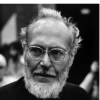W. Eugene Smith

W. Eugene Smith
William Eugene Smith, was an American photojournalist, renowned for the dedication he devoted to his projects and his uncompromising professional and ethical standards. Smith developed the photo essay into a sophisticated visual form. His most famous studies included brutally vivid World War II photographs, the clinic of Dr Schweitzer in French Equatorial Africa, the city of Pittsburgh, the dedication of an American country doctor and a nurse midwife, and the pollution which damaged the health of the residents of Minamata...
NationalityAmerican
ProfessionPhotographer
Date of Birth30 December 1918
CountryUnited States of America
I was after a set of pictures, so that when people looked at them they would say, ‘This is war’-that the people who were in the war would believe that I had truthfully captured what they had gone through I worked in the framework that war is horrible. I want to carry on what I have tried to do in these pictures. War is a concentrated unit in the world and these things are clearly and cleanly seen. Things like race prejudice, poverty, hatred and bigotry are sprawling things in civilian life, and not so easy to define as war.
... to became neighbours and friends instead of journalists. This is the way to make your finest photographs.
In music I still prefer the minor key, and in printing I like the light coming from the dark. I like pictures that surmount the darkness, and many of my photographs are that way. It is the way I see photographically. For practical reasons, I think it looks better in print too.
You can't photograph if you're not in love.
The first word I would remove from the folklore of journalism is the word objective.
My photographs at best hold only a small length, but through them I would suggest and criticize and illuminate and try to give compassionate understanding.
Available light is any damn light that is available!
I would that my photographs might be, not the coverage of a news event, but an indictment of war.
I try to take what voice I have and I give it to those who don’t have one at all.
Many claim I am a photographer of tragedy. In the greater sense I am not, for though I often photograph where the tragic emotion is present, the result is almost invariably affirmative.
I am constantly torn between the attitude of the conscientious journalist who is a recorder and interpreter of the facts and of the creative artist who often is necessarily at poetic odds with the literal facts.
...and each time I pressed the shutter release it was a shouted condemnation hurled with the hope that the picture might survive through the years, with the hope that they might echo through the minds of men in the future - causing them caution and remembrance and realization.
If I can get them to think, get them to feel, get them to see, then I've done about all that I can as a teacher.
I've never made any picture, good or bad, without paying for it in emotional turmoil.